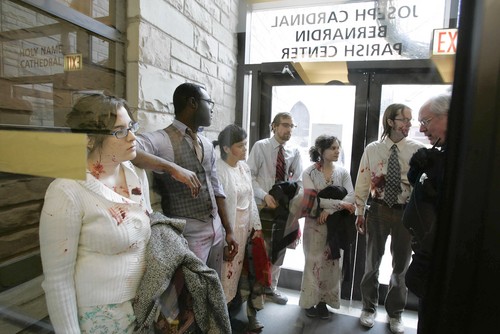Easter is one of those odd holy days turned secular holidays that creates a lot of incongruous images. Why do we have baskets with marshmallow bunnies instead of a nougat filled crucifix? Perhaps it is that kind of visual confusion that lead a group of protestors to create a new kind of visual Easter mix up.

On Sunday , a group calling themselves Catholic Schoolgirls Against the War stood up in Chicago’s Holy Name Cathedral right before Cardinal Francis George’s homily and sprayed stage blood on themselves and other worshipers. The gaps between visual display and reality are as confused here as they are between the Easter story and Peeps.
The problem, in my estimation, is that the protestors assumed a kind of visibility that exists in a vacuum. The image of protestors covered in fake blood, while perhaps a bit cliché, is powerful. It forces people to imagine bloodshed in everyday life to call attention to the real bloodshed war-torn nations experience. The protestors’ choice of venue was in some ways a wise one. The press was on hand to cover the Archdiocese of Chicago’s Easter celebrations, and so a broad kind of exposure was guaranteed. And so if good visual performance were limited to the creation of a powerful image that has a strong channel of circulation, this protest would have been a success. But visual communication, being communication, needs to recognize the other contingencies of meaning production.
The Catholic Church, by way of the global voice of the Pope and the national voice of the U.S. Conference of Catholic Bishops, has been clear in its opposition to the war. The setting of Holy Name Cathedral, then, serves as perhaps the most incongruous location for this protest. What’s more, the Chicago area has experienced a few high profile acts of public violence in recent months along with the unfortunately typical violence of urban life. And so a Catholic Church in Chicago is doubly problematic as the setting for this protest. The failure to recognize the setting that serves as a backdrop for the visual protest causes all kinds of problems for the protestors and undercuts their message. Some of the protestors suggested that the setting was appropriate because Cardinal George has visited with President Bush, but that line of reasoning suggests that leaders who disagree with the President over issues relating to the war should avoid him, and that indicates a certain lack of faith in the prospects of communication. Of course, if I were as poor at communicating as the Catholic Schoolgirls Against the War, I suppose I’d have a certain lack of faith in the prospects of communication as well.
Comments
In my course, I have my
In my course, I have my students take turns bringing in examples of protests. The student who went on Monday brought in this example that you've blogged about, and we watchedthis clip. What struck me while watching the protest was the audience's clapping, which occurs at a confusing point in the protest. The protesters chant "Even the Pope calls for peace!" are escorted out of the church, Cardinal George states, "So should we all," and the church audience claps. It seems that they are clapping for the Cardinal's pronouncement, but how do the audience members relate that to the protesters' protest of the war? Are they applauding the sentiment but not the tactics?
I think that confusion
I think that confusion reflects the really problematic disconnect in the protest. Shouting "Even the Pope calls for peace" at a Catholic mass as if the folks being interrupted don't have the same kind of relationship to the Pope through the structure of the Church is head scratcher. If you take your protest cry from the Pope, you give that authority a kind of legitimacy, but if you show up in a Catholic church to disrupt mass, you clearly don't respect the Church in a way that would give the chant any kind of conviction. And so, it seems the protest was designed with the simple goal of getting on camera, which isn't the most nuanced kind of visuality a cause ought to seek.